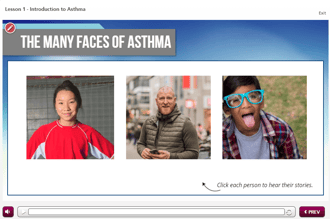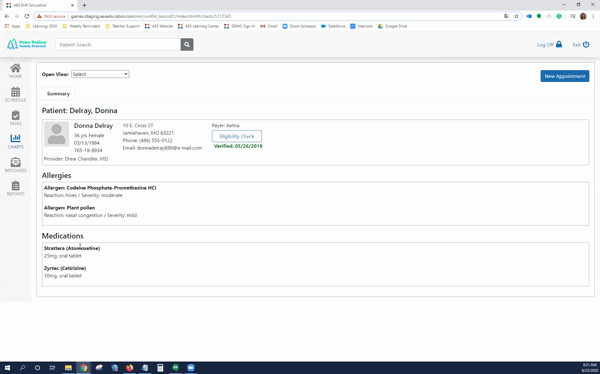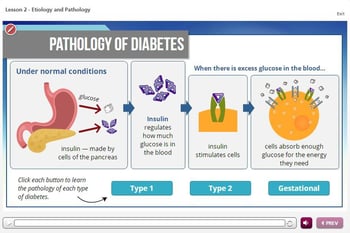Digital Curriculum | Health Science | HealthCenter21 | Student Engagement
5 Ways HealthCenter21 Boosts Student Interest and Engagement
For nearly 10 years, Bri has focused on creating content to address the questions and concerns educators have about teaching classes, preparing students for certifications, and making the most of the iCEV curriculum system.
We speak with dozens of CTE health science instructors every week who tell us they are unsure about implementing a new digital curriculum in their classes.
Very often, these teachers have had previous experiences with online software that was boring and led to students being burnt out from too much screen time.
Because of this, teachers considering our digital curriculum system, HealthCenter21, frequently ask how it helps keep students engaged and interested in the material.
In this article, you’ll learn five ways HealthCenter21 can help you keep students engaged:
- eLearning lessons are relevant and age-appropriate
- Creative instructional approaches increase interest and understanding
- Frequent interactions prevent passive learning
- Instructional design promotes engagement and learning transfer
- Blended learning materials boost engagement and reduce screen time
After reading this article, you’ll better understand how HealthCenter21 can help you improve student engagement so your students can better learn and retain information.
1. eLearning Lessons are Relevant and Age-Appropriate
Like any good book, learning should have a great story to tell and be relatable to the learners who encounter them.
HealthCenter21 is specifically designed for students in middle and high school CTE health science courses. So when developing lessons, our curriculum team keeps that age group top of mind.

One way we keep the lessons relevant to your students is by making the content relatable to something real in your students’ lives.
For example, when we expanded the Diseases and Disorders module, we included asthma and diabetes because even younger students likely know someone who has one of those diseases.
Additionally, you’ll find that the eLearning lessons depict diverse individuals that represent the learners.
Your students are young, diverse people, and the characters they see in their curriculum should reflect that.
When your students relate to the content, it increases their engagement and ownership in the learning process. That, in turn, increases the likelihood that they’ll remember the material long past the learning experience.
2. Creative Instructional Approaches Increase Interest and Understanding
As a health science teacher, there is probably a list of topics you dread teaching because you know your students find them boring or difficult to comprehend.
However, many of those concepts are critical to your students’ success on certification exams and their future careers!
Because of this, we incorporate a variety of instructional strategies to keep your students engaged while learning these crucial healthcare topics.
We accomplish this by adding interactive activities that require students to think critically and apply what they have learned in the eLearning lessons.
.gif?width=300&name=healthcenter21-lesson-example-cpr-activity%20(1).gif) For example, Unit 5 of the CPR and Basic Life Support module includes two learning activities that help students apply what they learned in the eLearning lessons.
For example, Unit 5 of the CPR and Basic Life Support module includes two learning activities that help students apply what they learned in the eLearning lessons.
The first activity, One-Person Adult Rescue, requires students to choose the correct actions to save a man who has suffered cardiac arrest. Throughout the activity, your student’s actions and answers are tracked, resulting in a total score presented at the end of the scenario.
The second learning activity in the CPR and Basic Life Support module is a Review Challenge that tests students on their knowledge of Basic Life Support using a Jeopardy-style game.
Your students will also find interactive learning games that help them learn new concepts and skills in a more hands-on way.
For example, the Client Status module includes a learning game on reading analog medical devices.
In the Reading Analog Devices game, students gain practice in reading and recording measurements from a glass thermometer, a balance beam scale, and the gauge of a sphygmomanometer.
Students start by going through a tutorial that shows them how to read each analog medical device. Once they complete the tutorial, students are given a set of eight patients who need their temperature, blood pressure, height, and weight recorded.
Throughout the game, students recall what they’ve learned in the tutorial to read and record each patient’s measurements.
Some modules also include simulated environments, such as the EHR Simulation module.

In the EHR Simulation module, students are introduced to the basics of an electronic health record system through hands-on experience using an EHR simulation.
The simulation is based on common, real-life scenarios students may encounter when working as medical assistants.
The EHR Simulation also includes a freeform “sandbox mode” that allows students to practice completing tasks in the simulation without guidance from the system. This is a great way to reinforce the workflows students have already completed by assigning variations on the learning scenarios.
Overall, by incorporating creative approaches, HealthCenter21 can take the burden off your shoulders to keep students interested in traditionally dull or difficult topics.
3. Frequent Interactions Prevent Passive Learning
“AES is a great learning tool. Rather than just looking at the textbook and just reading about it, because that doesn't really help you learn. But AES is really hands-on and engaging.”
Middle School Student
If you’ve used traditional materials such as textbooks or eBooks, you’re likely all too familiar with the sight of students losing focus during your class.
When teaching middle and high school students, you need to give students the opportunity to interact with and apply what they are learning in many ways.
That’s why we incorporate various interactions throughout the self-directed lessons your students access in HealthCenter21.

When going through the eLearning lessons, your students will actively engage with the content via:
- In-lesson questions
- Drag and drop
- Scenario-based videos
- Matching exercises
- Interactive examples
With HealthCenter21, you can feel confident that your students won’t just passively watch or read information. They’re required to think critically and make decisions throughout their learning.
For example, in Unit 3 of the Health Career Exploration module, students explore career opportunities in each healthcare pathway to discover more about specific job duties and educational requirements.
Throughout the lessons, students encounter videos about careers such as radiology technician, physical therapist, phlebotomist, and more. They will also complete lesson questions that require them to apply what they learn via the videos.
Here's one teacher's perspective on the difference interactive learning has made in her classes:
“I like the drag-and-drops because that is more of a psychomotor thing. If students just look at a picture with labels, it doesn’t resonate. But if they have to drag and drop it, they’re physically doing that.
Even though it’s a computer program, they’re still physically doing it, and that makes them remember things like the planes of the body and other stuff like that. I thoroughly love that part of HealthCenter21.”
Kozy Hubbard, Health Science Instructor
Bartow High School, FL
Overall, while you could teach this material by using traditional textbooks and handouts, interactive learning experiences make a more significant impact on your students’ engagement and understanding.
4. Instructional Design Promotes Engagement and Learning Transfer
As a CTE health science teacher, you face diverse students with different levels of knowledge and varying learning preferences.
Knowing this, our curriculum developers keep your students’ needs front of mind when creating new material.
In HealthCenter21, you’ll find various instructional design techniques that engage students and further enhance learning transfer.
 The graphics and multimedia within eLearning lessons illustrate key concepts and allow students to visualize the topics. Narration further enhances what is on screen by providing a detailed explanation.
The graphics and multimedia within eLearning lessons illustrate key concepts and allow students to visualize the topics. Narration further enhances what is on screen by providing a detailed explanation.
Students also encounter carefully-placed knowledge checks throughout the lessons to reflect on what they just learned.
Worksheets accompany each lesson to enhance spaced repetition of knowledge and are available in print or digital format. This allows you to customize your students’ experience and provides them with the opportunity to reflect on the material in their preferred form.
Finally, each module includes various activities and interactions that help students stay engaged while practicing what they have learned.
Here’s one teacher’s perspective on the changes she’s seen in her students’ interest since implementing AES:
“The engagement level has really gone up. Students really complement HealthCenter21, saying things like ‘I really like how it will tell and show you something then ask questions or has a game to go over what we just learned.’”
Maria Chavez, Medical Assisting Instructor
Grossmont Health Occupations Center, CA
5. Blended Learning Materials Boost Engagement (and Reduce Screen Time)
In the previous sections, we discussed how the eLearning lessons within HealthCenter21 could help keep your students engaged. However, the student-directed lessons are only one piece of the curriculum.
In HealthCenter21, you’ll also find hands-on activities, group projects, class discussions, lecture materials, and more - all structured according to our four-phase learning plan.
The four phases of the AES curriculum are:
- Explore: Teacher-led activities to hook students’ interest
- Learn & Practice: Student-directed eLearning within the system to learn new concepts and skills
- Reflect: Teacher-led activities to review and discuss key ideas
- Reinforce: Student-directed projects to enhance understanding of concepts and skills
This learning plan helps teachers like you create dynamic, blended learning experiences that hold your students’ attention.
For example, in the Personal Qualities module, students learn the bulk of the information in the Learn & Practice phase. On their own, the eLearning lessons will keep your students engaged as they work through the material.
However, when you incorporate the other phases from the module, students will:
- Demonstrate appropriate dress for healthcare workers in a fashion show
- Answer reflection questions
- Engage in class discussions
- Work in groups to complete healthcare problem-solving scenarios
- Work in teams to design medical equipment
- Review and discuss scenarios with conflicts
- Plan and organize a healthcare team meeting
- Research a current event
With HealthCenter21, you can use blended learning strategies to further engage your students without creating those extra materials yourself.
Keep Your Students Engaged While Preparing Them for their Future Healthcare Careers
Keeping students engaged is only one aspect of your role as a health science teacher. You also need to prepare your students for certifications and their future careers!
To do that, you need to find ways to increase student understanding and improve their long-term retention of information.
That’s why HealthCenter21 is designed to help you do more than just engage your students.
Read more about the student experience and how HealthCenter21 can help your students retain information for the long run:


